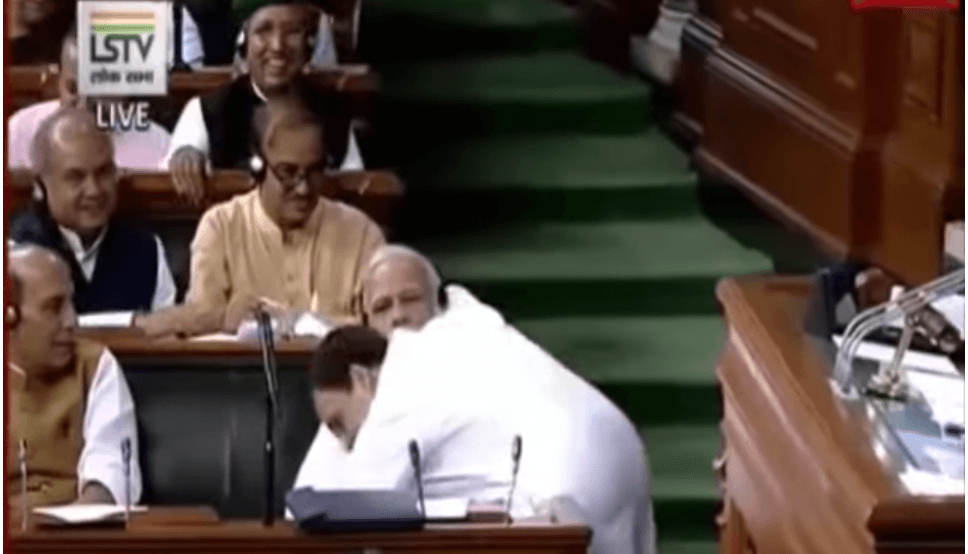Indian Prime Minister Narendra Modi is a hugger who is unafraid to show his affection to world leaders. He has embraced President Donald Trump, Vladimir Putin, Shinzo Abe, Benjamin Netanyahu – and even the erstwhile leader of the country’s biggest adversary, Nawaz Sharif, when he was still prime minister of Pakistan.
Yet he found himself entirely nonplussed and taken aback last week when Rahul Gandhi, leader of the opposition Congress Party, suddenly walked across the aisle, right after finishing a scathing attack on the ruling government, and wrapped his arms around the man he had just called incompetent. Imagine Hillary Clinton surprising Donald Trump in a clasp right at the close of their fiery presidential debates in 2016.
“The Hug,” as it is being called in India, was dramatic, unlikely and unexpected. The 48-year-old Congress leader was caught on camera winking at a colleague right after; he totally knew he had won the headlines. The Modi government handsomely won the no-confidence motion moved by the opposition in Parliament, but Gandhi won the talking points.
TV screen grab.
Gandhi wants us to believe that “The Hug” is the politics of love vs. the politics of hate – that a new-generation, metrosexual gentleness can combat hard-line machismo. One of the popular memes that capture “The Hug” shows Gandhi discovering that the prime minister’s chest is not quite the 56 inches it has been made out to be. The cartoon is a swipe at an old speech Modi made from the stumps in 2014, where he presented himself as a tough-guy strongman with a 56-inch chest who could not be bullied by his adversaries. “The Hug” has been offered as a turn-the-other-cheek moment that allows the Congress Party to claim the moral high ground – a sort of Gandhian (I mean Mahatma here) goodness that separates political differences from personal enmity.
But let’s not kid ourselves. None of this is about gobbledygook like love and compassion; politics is not a Hallmark card. “The Hug” was pure, deliberate, coldly crafted strategy, and it showed an astuteness that Gandhi’s detractors have rarely given him credit for. First, he used the element of surprise cleverly. The treasury benches expected to be attacked and abused; in fact, the prime minister looked amused when Gandhi was critiquing him. But “The Hug” caught him entirely unaware. He recovered swiftly enough to call his opponent back and pat him on the shoulder with a smile.
Later, in his parliamentary speech, Modi sarcastically said Gandhi’s walk across to his chair was an illustration of his desperation to be prime minister. But by that time, the defining image of the day already belonged to Gandhi. In this, he had borrowed from Modi’s own playbook. Modi has long been master of the message, in charge of scripting his own narrative that often bypasses media interviews and news conferences and is instead rooted in the power of the photo op. The till-now moribund Congress has been forced to play catch-up. But the party has now learned the new idiom of politics, acquired an edge on social media and sometimes outmaneuvers the BJP at its own game. “The Hug” was one such example.
The second clever thing that Gandhi did was to publicly own the jokes that are made about him. In the speech that preceded “The Hug,” he referenced how those who don’t like him call him “Pappu” (the condescending, sneering colloquialism for a bumbling, not-fully grown-up man). In appropriating the favorite put-down used against him, in a matter-of-fact, easygoing way, he finished its utility as an instrument of mockery.
But the political import of “The Hug” – and in this, Gandhi has taken a huge gamble – is that he has set himself as the main contender to take on Modi in the elections of 2019. His speech plus the embrace ensured that the prime minister spent much of his one-hour-long response focusing solely on the Congress Party and Rahul Gandhi; even Sonia Gandhi, his mother who led the Congress Party until her son took charge last year, ended up in Modi’s firing line. He barely dwelt on the other non-BJP parties, many of whom are represented by powerful regional leaders who could hold the key to the outcome in 2019. These men and women, who are massively powerful in the fiefdoms of their own states, also see themselves as prime minister material, whether it’s Mamata Banerjee in the east or Mayawati in the north. Given that a ragtag coalition of leaders will have to pool their resources and bury their egos to take on the domination of Modi, Gandhi played a high-risk hand by drawing attention – and Modi’s counterattack – to himself.
Modi would like nothing better than to make this a battle of two personalities – himself vs. Gandhi. Now Gandhi seems to show that he is up for the clash. But in doing so, he is taking a chance with the support of the non-Congress opposition, as they can’t be thrilled at all the attention he got in the media. He is also deviating from what could be a much more “war game”-like move to beat Modi. Most opposition leaders believe that the smarter move is to instead use a network of alliances and localize the elections in all 543 constituencies, which represents the strength of India’s Parliament. Gandhi’s Parliament gambit may have interfered with that strategy. It also puts a disproportionate burden on him to beat the most powerful prime minister that India has had in 30 years.
“The Hug” was Gandhi’s mischievous flirtation with what his life in 2019 might look like. He may have wooed voters with his flamboyance. When it comes to romance, we know that courtship is the easy part of building any relationship. But in the world of politics, the real work of keeping the voter interested will take more than headline-grabbing charm and chutzpah.
© Washington Post 2018
